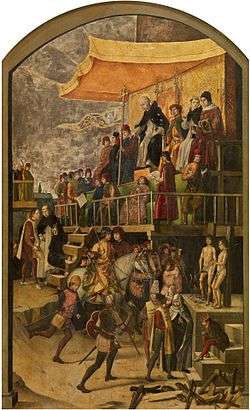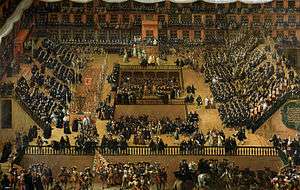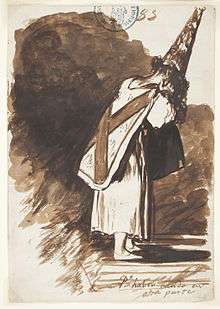Auto-da-fé

An auto-da-fé or auto-de-fé (from Portuguese auto da fé, meaning "act of faith") was the ritual of public penance of condemned heretics and apostates that took place when the Spanish Inquisition, Portuguese Inquisition or the Mexican Inquisition had decided their punishment, followed by the execution by the civil authorities of the sentences imposed.
The most extreme punishment imposed on those convicted was execution by burning. In popular usage, the term auto-da-fé, the act of public penance, came to mean the burning at the stake.
History
The first recorded auto-da-fé was held in Paris in 1242, under Louis IX.[2]
On 1 November 1478, King Ferdinand and Queen Isabella received permission from Pope Sixtus IV to name Inquisitors throughout their domains, to protect Catholicism as the true faith. It originally applied to the Crown of Castile — the domain of Isabella — but in 1483, Ferdinand extended it to his domain of the Crown of Aragon. Ferdinand's action met with great resistance, and resulted in the assassination by conversos in 1485 of Pedro de Arbués. In spite of this social discontent it is considered that between 1487 and 1505 the Chapter of Barcelona processed more than 1000 people, of which only 25 were absolved.[3]
The monarchs immediately began establishing permanent trials and developing bureaucracies to carry out investigations in most cities and communities in their empire. The first Iberian auto-da-fé took place in Seville in 1481; six of the men and women who participated in this first religious ritual were later executed.[4] Later, Franciscan missionaries brought the Inquisition to the New World.
The exact number of people executed by the Inquisition is not known. Juan Antonio Llorente, the ex-secretary of the Holy Office, gave the following numbers for the Inquisition excluding the American colonies, Sicily and Sardinia: 31,912 burnt, 17,696 burned in effigy, and 291,450 reconciled de vehementi (required to perform an act of penance).[5] Later in the nineteenth century, José Amador de los Ríos gave even higher numbers, stating that only between the years 1484 and 1525, 28,540 were burned in person, 16,520 burned in effigy and 303,847 penanced.[5] However, after extensive examinations of archival records, modern scholars provide lower estimates, indicating that fewer than 10,000 were actually executed during the whole history of the Spanish Inquisition,[6] perhaps around 3,000.[7]
The Portuguese Inquisition was established in 1536 and lasted officially until 1821. Its influence was much weakened by the late 18th century under the government of the Marquês de Pombal. They were also held in the Portuguese colony of Goa following the establishment of the Inquisition there in 1562–1563.
Autos-da-fé also took place in New Spain, the State of Brazil, and the Viceroyalty of Peru.[8] Contemporary historians of the Conquistadors, such as Bernal Díaz del Castillo, recorded them. Although records are incomplete, one historian estimates that about 50 people were executed by the Mexican Inquisition.[9]
Process

The auto-da-fé was a major aspect of the tribunals,[10] and the final step in the Inquisition process. It involved a Catholic Mass, prayer, a public procession of those found guilty, and a reading of their sentences.[11]
An Inquisition usually began with the public proclamation of a grace period of 40 days. Anyone who was guilty or knew of someone who was guilty was urged to confess. If the accused were charged, they were presumed guilty. Officials could apply torture during the trial. Inquisitors were required to hear and record all testimony. Proceedings were to be kept secret, and the identity of witnesses was not known to the accused.
After the trial, officials proclaimed the prisoner's sentence and administered in an auto-da-fé. The auto-da-fé was not an impromptu event, but thoroughly orchestrated. Preparations began a month in advance, and only occurred when the inquisition authorities believed there were enough prisoners in a given community or city. The ritual took place in public squares or esplanades and lasted several hours with ecclesiastical and civil authorities in attendance.[12]
Bordering the city's plaza, an all-night vigil would be held with prayers, ending in Mass at daybreak and a breakfast feast prepared for all who joined in.[13]

The ceremony of public penitence then began with a procession of prisoners, who bore elaborate visual symbols on their garments and bodies. These symbols were called sanbenito, and were made of yellow sackcloth. They served to identify the specific acts of treason of the accused, whose identities were kept secret until the very last moment. In addition, the prisoners usually had no idea what the outcome of their trial had been or their sentencing.
The prisoners were taken outside the city walls to a place called the quemadero or burning place. There the sentences were read. Prisoners who were acquitted or whose sentence was suspended would fall on their knees in thanksgiving,[14] but the condemned would be punished. Artistic representations of the auto-da-fé usually depict physical punishment such as whipping, torture, and burning at the stake.
The auto-da-fé was also a form of penitence for the public viewers, because they too were engaging in a process of reconciliation and by being involved were given the chance to confront their sins and be forgiven by the Church.
In popular culture
The auto-da-fé, usually represented as a heretic being burned at the stake, is a symbol used widely in the arts, especially in Europe.
- Voltaire featured an auto-da-fé held by the people of Lisbon after the 1755 Lisbon earthquake in chapter six of his anti-religious satire Candide (1759). The university of Coimbra decides that this "great ceremony was an infallible means of preventing the earth from quaking."
- Edgar Allan Poe – In "The Pit and the Pendulum", Poe uses the auto-da-fé as a reference point for the narrator as he tries to determine what is happening to him.
- Giuseppe Verdi – In his 1866 opera Don Carlos, Verdi includes a pivotal scene in the third act that depicts the beginning of an auto-da-fé in front of the Cathedral of Valladolid in Spain where heretics are about to be burned at the stake.
- Herman Melville – In Moby-Dick, near the end of Chapter 54, mentions auto-da-fé in passing: "'Though there are no Auto-da-Fe's in Lima now,' said one of the company to another; 'I fear our sailor friend runs risk of the archiepiscopacy. Let us withdraw more out of the moonlight. I see no need of this.'" In "The Confidence-Man: His Masquerade" (1857), set on a Mississippi steamboat filled with colorful characters and the Devil himself as the con-man, Melville weaves an allegory on how easily one may win over a person's, or for that matter, an entire people's confidence. The book opens with the words "Dedicated to victims of Auto da Fe."
- Leonard Bernstein composed and produced a musical adaptation of Voltaire's Candide in 1956, featuring a song called Auto-da-Fé that includes the chorus, "It's a lovely day for drinking and for watching people fry," referring to the spectacle of public executions.
- Elias Canetti won the Nobel Prize in Literature in 1981 for his work, especially his novel Die Blendung (1935), literally "The Glare," translated into English as Auto-da-Fé (1946).
- Fyodor Dostoevsky begins a chapter of The Brothers Karamazov with a "splendid Auto-da-Fé". The chapter is famously called "The Grand Inquisitor".
- Tennessee Williams wrote a one-act play entitled Auto-da-Fé (1938).
- Roger Zelazny wrote a short story, Auto-da-Fé, which appeared in Dangerous Visions, 1967.
- In Dai Sijie's Balzac and the Little Chinese Seamstress, the final climactic book burning is repeatedly referred to as auto-da-fé.
- José Saramago goes into detail about an Auto-da-fé in Baltasar and Blimunda (1982).
- Mel Brooks's cult comedy History of the World, Part I (1981) makes reference to the auto-da-fé in its segment about the Spanish Inquisition.
- The West Wing episode "7A Wf 83429", the first episode of the fifth season, when referring to a meeting where the Democratic leaders are going to punish them for invoking the 25th, Josh says "Anyone else coming to the auto da fe?"
- SPK titled their 1983 compilation album Auto Da Fe.
- In Matthew Lewis's Gothic novel The Monk (1796), madrileño monk Ambrosio barely escapes burning in an Auto da Fé. Convicted of rape and murder (which also turn out to be incest and matricide) he is sentenced to death by burning at the stake. He is rescued last-minute by intervention of Lucifer only to be left on a precipice in the Sierra Morena mountains. After falling down, insects drink his blood and mountain eagles "tore his flesh piecemeal, and dug out his eye-balls with their crooked beaks" before he perishes.
References
- Notes
- ↑
- at Prado Museum
- ↑ Stavans 2005:xxxiv
- ↑ «La Inquisició» Archived 16 November 2011 at the Wayback Machine., Històries de Catalunya, TV3, s.d.
- ↑ Cullen Murphy, God's Jury: The Inquisition and the Making of the Modern World, Houghton Mifflin Harcourt, 2012, pp. 65-69; ISBN 978-0-618-09156-0
- 1 2 Cecil Roth (1964) The Spanish Inquisition, W. W. Norton & Company, 1964 ISBN 0-393-00255-1, ISBN 978-0-393-00255-3 page 123
- ↑ Dedieu, p. 85; Perez, pp. 170–173.
- ↑ Monter, p. 53.
- ↑ Marcus, Jacob Rader (1999). "36". The Jew in the Medieval World: A Source Book, 315–1791. Detroit, MI: Wayne State University Press. pp. 202–203. ISBN 0-87820-217-X.
- ↑ Jose Rogelio Alvarez, ed. "Inquisicion" (in Spanish). Enciclopedia de Mexico. VII (2000 ed.). Mexico City: Sabeca International Investment Corp.. ISBN 1-56409-034-5
- ↑ Perry, Mary Elizabeth; Cruz, Anne J., eds. (1991). Cultural Encounters: The Impact of the Inquisition in Spain and the New World. Berkeley: University of California Press. ISBN 978-0-520-07098-1.
- ↑ Peters, Edward. Inquisition. New York: The Free Press, 1988.
- ↑ Many of the public autos-da-fé were described in contemporary published works listing the dignitaries in attendance, the condemned and their sentences. See for example, Matias de Bocanegra, Auto general de la fé..., Mexico: 1649
- ↑ Potter, Robert. The Auto de Fé as Medieval Drama. University of California, Santa Barbara. pp. 110–115.
- ↑ Potter, Robert. The Auto de Fé as Medieval Drama. University of Santa Barbara. pp. 115–119.
- Bibliography
- Arouet, Francois-Marie (Voltaire) (1758). Candide
- Dedieu, Jean-Pierre (1987) L'Inquisition. Les Editions Fides
- Kamen, Henry. (1997) The Spanish Inquisition : A Historical Revision. London: Weidenfeld & Nicolson.
- Lea, Henry Charles (1906–1907). A History of the Inquisition of Spain (4 volumes). New York and London.
- Monter, William (1990). Frontiers of Heresy. The Spanish Inquisition from the Basque Land to Sicily. Cambridge University Press
- Nabokov, Vladimir. (1989) Pale Fire. First Vintage International Edition. Random House. New York.
- Perez, Joseph (2006) The Spanish Inquisition: A History, Yale University Press. ISBN 0-300-11982-8, ISBN 978-0-300-11982-4
- Peters, Edward. (1988) Inquisition. New York: The Free Press.
- Stavans, Ilan. (2005) The Schocken Book of Modern Sephardic Literature. Random House, Inc. New York
- Steinbeck, John. (1932) "The Pastures of Heaven". Penguin.
- Whitechapel, Simon (2003). Flesh Inferno: Atrocities of Torquemada and the Spanish Inquisition. Creation Books. ISBN 1-84068-105-5
External links
| Look up auto da fe in Wiktionary, the free dictionary. |
- (Spanish) La Inquisición Española: origen, desarrollo, organización, administración, métodos y proceso inquisitorial
-
 Chisholm, Hugh, ed. (1911). "Auto-da-fé". Encyclopædia Britannica (11th ed.). Cambridge University Press.
Chisholm, Hugh, ed. (1911). "Auto-da-fé". Encyclopædia Britannica (11th ed.). Cambridge University Press.